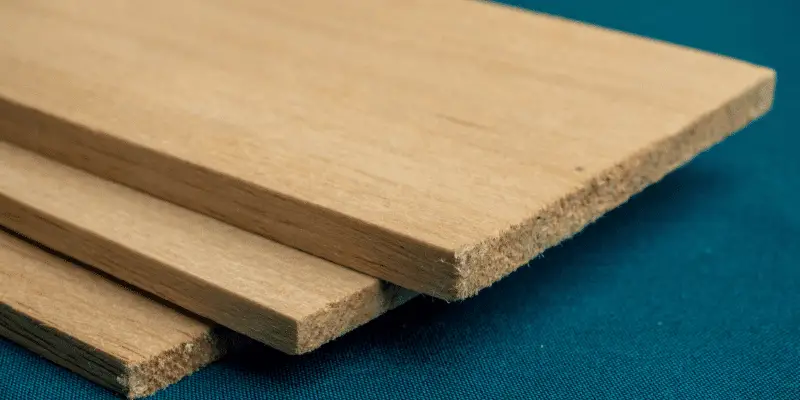Balsa wood is known for its lightweight and soft characteristics, making it suitable for crafting, while basswood is sturdier and more durable, making it ideal for structural purposes. Both types of wood have their own distinct features and applications in various industries, including model making, crafting, and construction.
Understanding the differences between balsa wood and basswood is crucial for selecting the right material for specific projects. We will delve into the unique properties of each type of wood, explore their advantages and disadvantages, and provide insights into their appropriate uses.
Whether you are a hobbyist, designer, or builder, knowing the differences between balsa wood and basswood will help you make informed decisions when it comes to choosing the right wood for your projects.
Understanding Balsa Wood And Basswood
Balsa wood and basswood are both popular choices for crafting and model making due to their lightweight and easy-to-work-with properties. Balsa wood is known for its softness and delicate grain, making it ideal for carving, while basswood is denser and offers more durability.
Each wood has its own unique characteristics, making them suitable for various projects.
Characteristics And Properties
Balsa wood, known for its lightness and strength, is a fast-growing tropical hardwood. It features a characteristic creamy-white color and a straight, uniform grain. The low density of balsa wood makes it extremely lightweight yet surprisingly durable, making it favored for various applications. On the other hand, basswood is also a lightweight wood, but it is slightly denser than balsa wood. It has a pale white to cream-colored appearance with a fine, even texture, making it versatile for different uses.
Common Uses In Different Industries
Balsa wood is commonly used in model aircraft, boats, and architectural prototypes due to its exceptional strength-to-weight ratio. It’s also utilized in the construction of surfboards and in the creation of intricate carvings and sculptures. Conversely, basswood is a popular choice for woodcarving, musical instruments, and intricate box making due to its workability, fine grain, and soft yet sturdy nature.
Strength And Durability Comparison
When it comes to choosing between balsa wood and basswood, one of the critical factors to consider is their strength and durability. Understanding the differences in density and hardness, as well as the pros and cons of their strength for various applications, is essential for making an informed decision about which wood type to use.
Density And Hardness Differences
Balsa wood is known for its low density and softness, making it exceptionally lightweight and easy to work with. On the other hand, basswood has a higher density and hardness compared to balsa wood, offering more strength and durability.
Pros And Cons Of Strength For Various Applications
When it comes to strength and durability, basswood is favorable for applications that require sturdiness, such as structural models, carving, and furniture making. While balsa wood may not be as durable, its lightweight nature makes it ideal for applications where weight is a crucial factor, such as aviation models and lightweight prototypes.

Workability And Versatility
When it comes to choosing the right type of wood for your crafting and construction projects, workability and versatility are crucial factors to consider. Both balsa wood and basswood are popular choices due to their unique properties. Understanding their differences in workability and versatility can help you make an informed decision for your next project.
Ease Of Cutting And Shaping
Balsa wood, known for its lightweight and soft nature, is incredibly easy to cut and shape. It can be effortlessly carved with simple hand tools, making it an ideal choice for intricate detailing and delicate designs. On the other hand, basswood, although slightly denser than balsa wood, also offers excellent workability. Its fine, even texture allows for smooth cutting and shaping, making it suitable for a wide range of crafting applications.
Suitable For Different Crafting And Construction Projects
Both balsa wood and basswood are highly versatile and suitable for various crafting and construction projects. Balsa wood’s lightweight and easy workability make it ideal for creating model airplanes, architectural prototypes, and sculptures. Additionally, its buoyancy makes it perfect for crafting floating structures and models. Basswood, with its strong and stable nature, is favored for carving, model making, and creating intricate wooden objects. It is also commonly used in architectural models, furniture making, and musical instrument construction due to its uniform grain and durability.
Cost And Availability
When considering the pros and cons of balsa wood vs basswood for your next craft or woodworking project, cost and availability are key factors to consider. Understanding the pricing comparison and availability in different regions and markets will help you make an informed decision on which wood to choose.
Pricing Comparison
Before diving into a new project, it’s essential to understand the cost implications of the materials you plan to use. Balsa wood is generally considered more expensive than basswood. The lightweight and versatile nature of balsa wood often come with a higher price tag compared to basswood, which is known for its affordability. The cost difference can be significant, especially for larger projects, making basswood a budget-friendly option for many crafters and woodworkers.
Availability In Different Regions And Markets
Both balsa wood and basswood are widely available, but the level of availability can vary depending on your location and local markets. Balsa wood, being native to South and Central America, may be more readily accessible in those regions. However, due to its popular use in various industries, balsa wood is typically stocked by specialized suppliers and hobby stores worldwide.
On the other hand, basswood, native to North America and Europe, is more readily available in these regions. It’s commonly found in lumberyards, craft stores, and online marketplaces, making it easily obtainable for woodworking enthusiasts across different regions.
Environmental Impact And Sustainability
The choice between balsa wood and basswood goes beyond their physical characteristics and applications. Understanding the environmental impact and sustainability of these materials is crucial in making informed decisions. Let’s delve into the Eco-friendly aspects and Long-term impact on biodiversity and ecosystems of both woods.
Eco-friendly Aspects
When comparing balsa wood and basswood from an environmental perspective, several factors come into play. Balsa wood is well-known for its rapid growth, with some species reaching maturity in as little as 5 to 10 years. This fast growth rate allows for sustainable harvesting and reduces the pressure on natural forests. On the other hand, basswood, although renewable, generally takes longer to mature, requiring more time to replenish.
Furthermore, balsa wood is often sourced from managed plantations, where trees are regularly replanted to maintain the balance between harvesting and regrowth. This sustainable approach minimizes the impact on natural habitats and promotes biodiversity within the ecosystems.
Long-term Impact On Biodiversity And Ecosystems
The long-term impact of utilizing balsa wood versus basswood extends to their effects on biodiversity and ecosystems. Balsa wood’s rapid growth and sustainable harvesting practices can contribute to the preservation of biodiversity by reducing the need for logging in old-growth forests. Additionally, the establishment of balsa plantations provides habitats for various species, fostering a more diverse and balanced ecosystem.
Conversely, the slower growth rate and longer regeneration time of basswood may lead to more significant disruptions in natural habitats during the harvesting process. This could potentially affect the overall biodiversity and ecological stability in certain regions where basswood is extensively sourced.
Frequently Asked Questions On Balsa Wood Vs Basswood
What Are The Key Differences Between Balsa Wood And Basswood?
Balsa wood is lighter and softer, making it ideal for crafting models, while basswood is harder and denser, suitable for carving and furniture making. Both woods offer different strengths and weaknesses, so choose based on your project needs.
Can Balsa Wood And Basswood Be Used Interchangeably In Projects?
While balsa wood and basswood both have their unique qualities, they can sometimes be used interchangeably, depending on the specific project. Understanding the characteristics of each wood will help determine which is best suited for your needs.
Are Balsa Wood And Basswood Sustainable Materials?
Both balsa wood and basswood are considered sustainable materials, as they are fast-growing and widely available. Their renewable nature makes them environmentally friendly choices for various crafting and building projects.
Conclusion
Both balsa wood and basswood have their unique characteristics for different uses. Deciding between the two depends on the specific project requirements. Understanding their differences and applications is crucial for choosing the right material for your woodworking projects. Overall, both woods offer versatility and can enhance your craftsmanship.



One thought on “Balsa Wood Vs Basswood: The Ultimate Comparison”